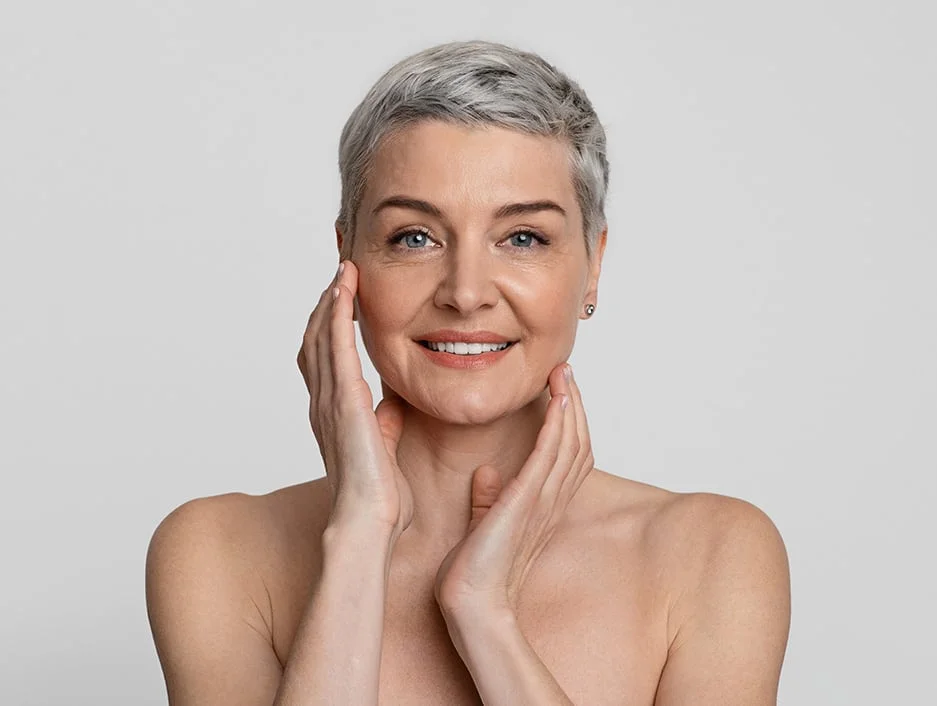Blepharoplasty, or eyelid surgery, is designed to rejuvenate and refresh the appearance of the upper and/or lower eyelids by reducing excess skin and minimizing puffiness and droopiness in the area. Due to genetic predisposition, the natural process of aging, and other factors, skin laxity can develop on the upper eyelids and drooping and/or puffiness can form on the lower eyelids. Dr. Neal Goldberg, a leading plastic surgeon, is proud to offer cosmetic eyelid surgery to combat droopy or puffy eyelids. This type of facial plastic surgery can help:
- Correct drooping or puffy eyelids
- Remove excess skin of the eyelids
The result can be a brighter, more youthful, and more rested look in the upper face. If drooping skin is resting on the lash line and/or interfering with your line of sight, Dr. Goldberg can also eliminate this “hooding” effect.
Am I Good Candidate For Eyelid Surgery?
Eyelid surgery, also known as blepharoplasty, is most commonly performed on patients 35 years-old and above. In fact, more than 200,000 individuals underwent eyelid surgery in the US in 2009, according to the American Society of Plastic Surgeons. These patients chose surgery to correct stretched skin and baggy or droopy eyelids, which can often be hereditary. If you’re in good general health and have related concerns that can be addressed by eyelid surgery, this procedure may be right for you.
If you suffer from any of the following conditions, then you may not be a good candidate for eyelid surgery: thyroid problems like hypothyroidism and Graves’ disease, dry eye or insufficient tears, high blood pressure, cardiovascular disease, diabetes, and detached retina or glaucoma.
There’s a wide range in what plastic surgery can achieve – dramatic or subtle outcomes. Sometimes a little goes a long way.

What Are The Different Types Of Eyelid Surgery?
Several techniques are available to enhance the appearance of the eyelids, and the right one for you may be one or more approaches. During your initial consultation, Dr. Goldberg will review your characteristics, discuss your goals, and talk to you about your options. The most common eyelid surgery techniques include:
Upper Blepharoplasty
This procedure is performed on the upper eyelids. Excess skin is trimmed and lax muscles are repositioned to give the eyes a more “open” appearance. If drooping tissue obscures your vision, you should notice an improvement in your range of visibility once healed. In some instances, excess fat may also be removed, and Dr. Goldberg is careful to provide natural-looking results that do not appear “tight” or over-corrected.
Lower Blepharoplasty
As the name indicates, lower blepharoplasty addresses the lower eyelids. Several methods are available to remove excess fat and tissue, as well as to soften the appearance of under-eye bags and puffiness, including a scar-less technique called transconjunctival blepharoplasty.
Asian Blepharoplasty
Asian eyelid surgery is a procedure designed to create a “double eyelid,” or a natural crease in the upper eyelids. Generally speaking, some individuals of Asian ancestry may lack an upper eyelid crease (although this aesthetic can affect patients of any background). This treatment is performed purely for cosmetic reasons, as some people prefer the appearance of a crease because it can make the eyes appear more open.
Transconjunctival Blepharoplasty
Transconjunctival eyelid surgery is a form of lower blepharoplasty that aims to reduce eye bags and puffiness below the lower lids. This technique distinguishes itself from a standard lower eyelid procedure through the use of an internal incision, which leaves the external eyelid skin unscarred. Dr. Goldberg performs the transconjunctival procedure by making a small incision on the inside of the lower eyelid, allowing him to remove/reposition protruding fat deposits contributing to the appearance of baggy eyes. This approach can be much more effective than over-the-counter creams and collagen strips, which patients often utilize to smooth the lower eyelid contour only to be met with limited results.
What Can I Expect From The Eyelid Surgery Procedure?
Prior to surgery, you may need to undergo a medical evaluation, including a vision test in which the ophthalmologist will share relevant information with Dr. Goldberg. The surgery is usually done on an outpatient basis and takes between 1-3 hours to complete. A local anesthetic will be used to numb the area around the eyes. Dr. Goldberg will then make incisions within the creases of the upper eyelids, following the natural lines of the eyelids, and below the lashes in the lower lids.
Dr. Goldberg then separates the skin from the fatty tissue and muscle underneath, repositioning or removing the excess fat. Sagging muscle and skin are also trimmed. Using very fine sutures, Dr. Goldberg closes the incisions. He may also opt to use the transconjunctival eyelid surgery technique, which requires making an incision in the lower lid; only a conservative amount of fat will be removed.
Dr. Goldberg customizes the procedure to best suit the needs and goals of each individual. Some people may only desire upper eyelid surgery, and others only lower. In many instances, both areas will be addressed in the same operation. Excess skin and fat will be trimmed and removed, some fatty tissue may be repositioned, and sagging musculature might also be trimmed or tightened. Care is given to ensure incisions are placed as inconspicuously as possible. Most patients can return home the same day.
What Will My Life Be Like After Eyelid Surgery?
After the procedure is complete and you return home, we recommend that you relax and take time off work for about 10 days. You should keep your head elevated as much as possible the first few days. Soon after surgery you may notice that your eyes feel a little sore or tight, and these effects are normal. Some swelling and bruising are also to be expected and using cold compresses can help to reduce your discomfort. Additionally, we may provide prescription medication to make your recovery as pleasant as possible. It’s important to note, you should not wear contact lenses for at least two weeks after eyelid surgery, and you should avoid strenuous exercise for about three weeks.
When Will I Be Able To See The Results?
Some people, depending on their treatment plan and unique condition, may be able to see some signs of improvement soon after surgery. In most cases, however, results will take several weeks and even months to appear. Swelling should gradually decrease, and the final outcome should be visible after about six to 12 months. It’s not unusual to still have some bruising and noticeable swelling after four to six weeks. If you ever have any questions about your procedure or recovery, we encourage you to reach out to us for more information.
While blepharoplasty can “turn back time,” in a manner of speaking, and give individuals a more youthful appearance, the clock continues to move forward. Some of the factors that can affect the duration of eyelid surgery results include genetic and lifestyle influences. It’s possible to maintain your outcome for as long as 10-15 years or perhaps more in some instances, particularly if you take good care of your skin. Dr. Goldberg recommends using sunscreen daily and avoiding smoking.
Will There Be Any Visible Scars?
Once healed, the incisions are often virtually unnoticeable. Dr. Goldberg utilizes very fine sutures that help the incisions to heal smoothly. For upper eyelid surgery, incisions can be concealed in the natural eyelid crease or fold. For lower eyelid surgery, a transconjunctival technique may be used, which places the incision on the inside of the lower eyelash line. As a result, the scars from this procedure are practically invisible. While the marks may be visible for a short while after the operation, with time they should fade in color and become smoother and less perceptible.
How Much Does Eyelid Surgery Cost?
We believe that patients benefit from customized treatment plans that tailor a cosmetic program to their unique needs and goals. As a result, the price of eyelid surgery can vary from one person to the next. We recognize that cost can be an important factor for most patients, and we will provide a detailed estimate of the total cost for your procedure at your initial visit. This quote will include the anticipated fees for anesthesiology and the hospital as well as the surgeon, so that you can make the best choice for your budget and lifestyle. Please note, it is not always common practice for a plastic surgeon to offer this information, so be sure and check what is included in any estimate.
The average cost of upper eyelid surgery is $4,000, and lower eyelid surgery ranges from $6,000-$12,500. This number is inclusive of all cosmetic surgery fees. To help make aesthetic enhancement accessible to as many interested individuals as possible, we work with plastic surgery financing agencies who offer appealing payment plans to eligible applicants. We can discuss this more during your initial consultation, if desired.
Will Insurance Cover Blepharoplasty?
The skin of the upper eyelids may become so inelastic that the tissue folds over the eye, obscuring vision. If this describes your experience, your medical insurance may partially cover the cost of your eyelid surgery. The amount of visual impairment will need to be documented, and Dr. Goldberg will work closely with your ophthalmologist to determine the appropriate treatment. Not all insurance policies cover the same techniques, and we recommend you speak with your agent to clarify your level of coverage.
Are There Any Potential Blepharoplasty Complications?
The risks of eyelid surgery typically include dry eye, infection, irregular positioning of the eyelid, and scarring. While the risk of complications exists with any surgery, the likelihood of negative outcomes is greatly reduced when blepharoplasty is performed by a board-certified plastic surgeon with training in aesthetic procedures. Having undergone several residencies in cosmetic and reconstructive surgery as well as continuing education courses that help refine his techniques, Dr. Goldberg has the skills and decades of experience to achieve optimal results with blepharoplasty. He performs all procedures in his fully accredited Scarsdale surgical facility with his team of board-certified anesthesiologists and registered nurses. During your consultation, Dr. Goldberg will go over the potential risks and benefits of eyelid surgery so you have the information to make the best decision for your goals. He will also review your medical history and examine your concerns to help ensure you are a good candidate for blepharoplasty.
Is Eyelid Lift Without Surgery Possible?
While non-surgical treatments cannot provide the same quality and longevity of results, options do exist to address under-eye bags and puffiness. If your concern is excess tissue, however, typically only surgery will be effective. For a minimally invasive option to enhance the overall appearance of the eye area, Dr. Goldberg offers a number of cosmetic injectables that can soften common signs of aging. Through our affiliate medical spa, laser skin resurfacing and skin tightening treatments may also be of interest. Our medical team will be happy to provide additional information at your request.
Additional Eyelid Surgery FAQS
When Can I Wear Contacts Again After Blepharoplasty
What Will My Eyes Feel Like After Eyelid Surgery?
When Can I Wear Makeup After Eyelid Surgery?
How Can I Reduce Swelling After Blepharoplasty?
What Is The Difference Between Blepharoplasty And Ptosis Repair?
What Age Should Eyelid Surgery Be Performed?
Can Blepharoplasty Improve Dark Circles And Under-Eye Hollows?
What Is Upper Eyelid “Hooding”?
What Is The Consultation For Eyelid Surgery Like?
How Can I Preserve The Outcome Of Blepharoplasty?
For more information about eyelid surgery procedures, call our office for a consultation at 914-722-1600.
*Individual Results May Vary











